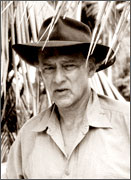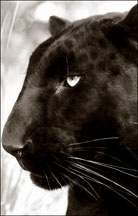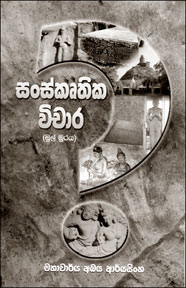|

Lured by the Prince of Darkness
Title: The Glenthorne Cat
and other amazing leopard stories
Compiled and Edited by:
Christopher Ondaatje
Distributed by: Visidunu
Prakashakayo
Reviewed by: Aditha Dissanayake
[email protected]
*************
 Christopher Ondaatje was born in Ceylon, educated in England, and
emigrated to Canada in 1956. He has worked at several magazines and
newspapers, and in 1967 founded Pagurarian Press, which eventually
became the enormously successful Pagurian Corporation. In 1988 he sold
all his business interests and returned to the literary world. Christopher Ondaatje was born in Ceylon, educated in England, and
emigrated to Canada in 1956. He has worked at several magazines and
newspapers, and in 1967 founded Pagurarian Press, which eventually
became the enormously successful Pagurian Corporation. In 1988 he sold
all his business interests and returned to the literary world.
He is the author of ten books, including the best-selling Burton
biographies Sindh Revisited, and Journey to the Source of the Nile; and
more recently Woolf in Ceylon and The Power of Paper. He was a member of
Canada’s 1964 Olympic bobsled team, is a Fellow of the Royal
Geographical Society and a Trustee of the National Portrait Gallery.
He lives in London, England and was knighted by the Queen in 2003.
***************
 When Upekha of Visudunu Prakashakayo gifted me Christopher Ondaatje’s
The Glenthorne Cat and Other Amazing Leopard Stories, I day dreamt of
writing the best review I had ever written so far for Writer’s Den. When Upekha of Visudunu Prakashakayo gifted me Christopher Ondaatje’s
The Glenthorne Cat and Other Amazing Leopard Stories, I day dreamt of
writing the best review I had ever written so far for Writer’s Den.
Never having reviewed Christopher Ondaatje before this, I thought
here is a book I could go to town on. This will be THE review of my
life.
Say that again! As in most other day dreams when I dreamt of writing
this I had conveniently ignored the most important fact - the subject of
the book. Having let the words “Compiled and Edited by Christopher
Ondaatje fascinate me it was only after I had seriously begun to read
the Glenthorne Cat that it occurred to me that animals, even though I
love them, do not attract me as much as humans do. Given a choice I
would much rather read a book on anthropology (perhaps ‘Window on
Humanity’ by Conrad Kottak), than about the behaviour patterns of
leopards.
No wonder then, by the time I reached page 107, I felt as though the
black cat had his paws tightly round my neck - strangling me to death.
Perhaps this was because I did it the wrong way - eager to write the
review I tried to read all the chapters in one go. Now suffering from an
overdose of wild cat stories I wish I had taken one story at a time. Had
I done so, this review may have taken a different twist. But as things
stand right now, I confirm if I were stranded on a desert island I
wouldn’t want to have the Glenthorne Cat as my sole companion.
Yet, for those who are fascinated by these cat-like creatures with
black or dark grey fur, a long tail and green eyes” the information
found in all the “Man-eating Chapters” will be of great interest.
Here is how Jim Corbet explains in “The Man-Eating Leopard of
Rudraprayag”, how a leopard turns into a man-eater. “The people of
Garhwal are Hindus, and as such cremate their dead.”
 In normal times these rites performed on the bank of a river are
carried out very effectively; “but when disease in epidemic form sweeps
through the hills, and the inhabitants die faster than can be disposed
of, a very simple rite, which consists of placing a live coal in the
mouth of the deceased, is performed in the village, and the body is then
carried to the edge of the hill and cast into the valley below. In normal times these rites performed on the bank of a river are
carried out very effectively; “but when disease in epidemic form sweeps
through the hills, and the inhabitants die faster than can be disposed
of, a very simple rite, which consists of placing a live coal in the
mouth of the deceased, is performed in the village, and the body is then
carried to the edge of the hill and cast into the valley below.
A leopard, in an area where its natural food is scarce, finding these
bodies, very soon acquires a taste for human flesh, and when the disease
dies down and normal conditions are re-established, he very naturally,
on finding his food supply cut off, takes to killing human beings.”
Yes, on a desert island, I would not want to have the Glenthorne Cat
for a companion. But stuck in a traffic jam on my way to office on a
Tuesday morning I would not mind sharing my time with her. Here is why.
The description given about the “beginnings of Ceylon” by Ondaatje to
the late Reverend Halliday; who had died in 1872 but continues to hang
around Glenthorne (Lorna Doone Country) Ondaatje writes “The stories
I’ve been told and read in a translation of the Mahavansa, tell of the
daughter of the king of Kalinga, a beautiful girl with a passionate
character so much so that her parents were ashamed of her lustful
nature.
Walking in the wilderness one day, she was approached by a lion
prowling for his pray; far from being afraid she caressed and excited
him. The lion placed her on his back and carried her back to his den. It
is said that the twins who resulted from this strange union bore the
lion’s paws in place of their hands and feet... Sinhabahu founded a city
called Sihaparu and went on to sire sixteen sets of twins.
The eldest twin was called Vijaya but Viyaya grew up to be a lawless
character, a violent ruffian. The king banished his son from this
riotous ways and sent him into exile in a rudderless boat. Eventually
when he had reformed his ways and gained the wisdom of experience, he
landed at Tambapanni... Vijaya is the founder of the Sinhala race..”
That the leopard, out of all animals deserve the epithet, the “Dark
Prince” is aptly illustrated in Anna Kavan’s “A visit” and Honor
Balzac’s A Passion in the Desert. Ana reflects upon the lithe muscular
shape lying next to her the way a woman responds towards a lover when he
falls asleep beside her after knowing her the way only a man can know a
woman. “I watched the regular contractions and expansions of the deep
chest, admired the elegant relaxed body and supple limbs...” writes Ana.
The night is made all the more fascinating by the references to “a
mild primeval smell of sunshine, freedom, moon and crushed leaves,
combined with the cool freshness of the spotted hide, still damp with
the midnight moisture of jungle plants.”
The short description of the visitor is so avid, the reader too feels
Ana’s loss when she wakes up “in the faint light of dawn” to find he had
already got up and left the room” Balzac too describes the same passion
towards this beautiful enigmatic and sometimes the most dangerous of the
big cats through the story of a French soldier who discovers he has
unintentionally become the first love of “a queen of the sands”.
They look at each other “pregnant with meaning.” She trembles with
delight. (the coquettish creature) when she felt her friend scratch the
strong bones of her skull with his nails. Her eyes glitter...then she
close them tightly. “She has a soul” he cries. How does it all end -
this friendship between two beings who seemed to understand each other
so thoroughly?” Wouldn’t you like to know? My lips though, are sealed.
The glimpses into the past too are fascinating. In the Man Eater of
Punanai, an old man talks about the pre television era when in the
evening “people will tell old tales from the Mahavansa”.
So too the superstitions surrounding Glenthorne. According to E.W.
Hendy, the author of Wild Exmoor through the Year, “You can keep a witch
away by driving a nail into her footprint. You can always tell the
number of years before you will be married by hanging a sheep’s heart in
your house and counting the drops of blood that drop from it.
And here is a piece of advice everyone who has known love, who is in
love or who is about to fall in love should know “Never burn old love
letters.
it is unlucky”.
Read it. From the gutters of Paris to the hamlet of Sivanipalli, The
Glenthorne Cat may not seem to be what she really is. Here, as in the
desert “there is all, and there is nothing”. Explain this? Turn to page
101.
Cultural Issues Re-examined
Author: Professor Abaya
Aryasinghe
Publisher: Saraswati Press,
Divulapitiya
Reviewed by Sirisaman Wijetunge
 “Cultural Issues Re-examined is the English title of a Sinhala book
recently published. Its Sinhala title is SANSKRIT VICARA. The author is
Professor Abaya Aryasinghe, former Professor of Archaeology, University
of Kelaniya. “Cultural Issues Re-examined is the English title of a Sinhala book
recently published. Its Sinhala title is SANSKRIT VICARA. The author is
Professor Abaya Aryasinghe, former Professor of Archaeology, University
of Kelaniya.
Cultural issues in any country are changeable from time to time
depending on fresh evidence. It should be noted that there is a trend
among the public not to admit any new theory despite emergence of strong
evidence.
There are a number of points corrected by Professor Senarat
Paranavitana depending on strong evidence. Yet the conservative minded
readers are rather reluctant to admit them. Professor Paranavitana tops
the list of reserchers who had altered the map of the cultural field in
our country. He confidently identified the Abhayagiri stupa and the
Jetavana stupa.
He proved that so-called Elara Sohona was the Dakkhina thupa. He also
attributed meaning to damsels appearing in the Sigiri frescoes. The blue
colour ladies represent rain cloud (Megha-lata) and the golden colour
ones represent Lightening (vijju-kumari).
The statue standing on the bank of Parakrama Samudraya at Polonnaruva,
according to Professor Paranavitana, amounts to a commendable attempt to
depict the features of an ideal and just king adorned with
characteristics of justice (dhamma) and economy (artha).
It is however not the representation of king Parakramabahu I. These
are only a few points Professor Paranavitana had commented on.
The author of Cultural issues re-Examined follows the steps of
Professor Paranavitana and ventures to comment on some of the knotty
problems found in the cultural field.
This author selects about fifty items covering sculpture,
inscriptions and language etc., and catygorises them into ten sub
headings in this collection of essays. The so-called Dutugamunu statue,
the figure of Ganadev at Mihintale, Royal titles of ancient kings etc.
The etimology of Sinhala words such as Dameda Handa-mama, Ayubovan
etc., the kandyan kings, Tamils and identifying the God of Kataragama
are some of the topics dealth with in this collection of Essays.
Some of the points raised by the author are subject to controversy,
and open to challenge.
This collection of essays, in a way amount to an attempt directed
towards the advancement of knowledge in the field of culture.
If you were lucky enough to miss it:
That three letter word
By Aditha Dissanayake
[email protected]
 Samuel Butler said it best: “Being ill is one of the greatest
pleasures of life, provided one is not too ill and is not obliged to
work until one is better.” If you need a second opinion the person you
should see is Harold Nicholson who will surely try to persuade you that
“One of the minor pleasures in life is to be slightly ill.” Samuel Butler said it best: “Being ill is one of the greatest
pleasures of life, provided one is not too ill and is not obliged to
work until one is better.” If you need a second opinion the person you
should see is Harold Nicholson who will surely try to persuade you that
“One of the minor pleasures in life is to be slightly ill.”
But what did Butler mean when he said “not too ill?” Did he mean a
high fever (with chills a dry cough, sweating, muscle aches, pains and
the “I’ve been run over by a bus” feeling? Or could he have meant lying
on the couch at ten in the morning watching a young man talk about
hairdressing in neither Sinhala nor English (mona vage objective ekak da
me vage style ekakin achieve karanna puluwan?) because you are too tired
to crawl across the floor to pick up the remote? Above all could he have
meant having the following conversation with your spouse?
“I think this is it. Remember wherever I might be I love you.”
“You’re not dying; give it a break.”
“I’ve been sick now for almost three hours. I don’t know how much
longer I’m going to last. Come close and be with me for just a moment
while I can still see you ...”
“Gosh is it seven o clock already?. I am going to watch the news” And
he leaves wondering what has happened to the match between X and Y.
Yes, it was tough having the flu last week. Especially when we went
down with it together - my colleague Chinthaka and I. But thanks to the
untiring efforts of the rest of my pals who generously lent me their
shoulder to lay our troubles on, Writer’s Den managed not to close shop.
And what did I do apart from clicking from one tv channel to the
other watching commercials about various life-giving, over-the-counter
remedies that only work for the actors on the screen or dramatically
dropping the remote control as if my life had started to ebb to grab the
attention of whoever was around, throughout last week?
I found solace in books. I read all about how to avoid the flu and
colds. Here is what Robert Benchley says in “Benchley... or Else”.
“Don’t breath through your mouth or nose. These two orifices have
been called “The Twin Roads to Germville”. So long as people use their
mouths and their noses to breathe through, we are going to have
epidemics, plagues and eventual disintegration of the human race.”
“Avoid crowds.” continues Benchley. You never know who may be in a
crowd. He suggests the best way to do this is to stay right in your room
all day with the door locked. Benchley also stresses the importance of
getting plenty of sleep.
This would mean when your mother comes to wake you up in the morning,
pulling the sheets up over your head and telling her you are not going
out today because you are avoiding the flu. If during the afternoon you
feel drowsy between writing one article and another, put your head on
your desk and take a little nap. Your colleagues will understand if you
put a little sign in front of you saying “Writer asleep. Flu
prevention”. After all this is the season for flu.
Benchley also says to stay in a temperature of between sixty and 70
degrees, which “can be done by going to a beach resort and lying on the
sand for a month or so. Be sure to lie face up” advises Benchley” so
that the sun can send its actinic rays across your chest and into your
eyes”.
In addition, you should eat anything that makes your mouth water,
quite forgetting what Mark Twain said about “feeding a cold and starving
a fever”. Above all “No exercise. This is all important because exercise
according to Benchley only stirs up the poisons in your system.
Next time I get sick I’m going to really enjoy it.
But right now, (cough, cough) its Koththamalli time!n |
